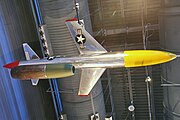m (Remove some templates. interwiki links, delink non military terms, add link to Wikipedia and cleanup) |
m (→External links: Remove some templates. interwiki links, delink non military terms, cleanup and move Wikipedia link above categories, replaced: ==References== ;Citations {{reflist}} ;Bibliography {{refbegin}} *{{cite web |url=http://www.design...) |
||
| Line 153: | Line 153: | ||
{{Missile types}} |
{{Missile types}} |
||
}} |
}} |
||
| + | |||
| ⚫ | |||
[[Category:Air-to-air missiles of the United States]] |
[[Category:Air-to-air missiles of the United States]] |
||
| Line 159: | Line 161: | ||
[[Category:World War II guided missiles of the United States]] |
[[Category:World War II guided missiles of the United States]] |
||
[[Category:Ramjet-powered aircraft]] |
[[Category:Ramjet-powered aircraft]] |
||
| − | |||
| ⚫ | |||
Revision as of 18:23, 16 February 2014
| Gorgon | |
|---|---|
 A PTV-N-2 Gorgon IV missile on a Northrop P-61A mother-ship | |
| Type | missile / reconnaissance drone / target drone |
| Place of origin | United States |
| Production history | |
| Designer | Naval Air Development Center (NADC) |
| Designed | 1940s |
| Produced | from 1943 to 1953 |
| Specifications | |
| Mass | PTV-N-2 - 1,598 lb (725 kg) |
| Length | PTV-N-2 - 22 ft (6.6 m) |
|
| |
| Engine | PTV-N-2 - Marquardt XRJ30-MA ramjet |
| Wingspan | PTV-N-2 - 10.0 ft (3.05 m) |
| Flight ceiling | PTV-N-2 - 35,100 ft (10,700 m) |
The Gorgon was an air-to-air missile powered by a turbojet engine and equipped with radio controls and a homing device.

PTV-N-2 Gorgon IV in Steven F. Udvar-Hazy Center

RTV-N-15 Pollux in Steven F. Udvar-Hazy Center
It was developed by the U.S. during World War II, was later expanded into a more general program including turbojet, ramjet, pulsejet, and rocket power. Straight wing, swept wing, and canard (tail first) air frames were investigated and visual, television, heat-homing, and three types of radar guidance were looked at for use as possible air-to-air, air-to-surface and surface-to-surface guided missiles and as target drones.
The final development of the series, the ASM-N-5 Gorgon V, was to be an unpowered chemical weapons dispenser.
Variants
Data from:[1]
- Gorgon IIA
- Canard layout with single rocket
- KA2N-1 -
- KU2N-1 -
- CTV-4 -
- CTV-N-4 -
- Gorgon IIB
- Canard layout with single pulse-jet
- Gorgon IIIA
- Conventional layout with single rocket
- KA3N-1 -
- KU3N-1 -
- CTV-6 -
- CTV-N-6 -
- Gorgon IIIB
- Gorgon IIIC
- Conventional layout with twin rockets
- KA3N-2 -
- KU3N-2 -
- RTV-4 -
- RTV-N-4 -
- Gorgon IV
- Single ramjet
- KUM-1 -
- PTV-2 -
- PTV-N-2 -
- Gorgon V
- Derivative of Gorgon IV
- ASM-N-5 Gorgon V - proposed chemical weapons dispenser variant
- NADC Plover
- Drone variant of Gorgon IV
- KDM-1 -
- NADC Pollux
- Similar to Gorgon IIC
- RTV-N-15 -
- KGN-1
References
- Citations
- ↑ Parsch 2005
- Bibliography
- Parsch, Andreas (2005). "Martin ASM-N-5 Gorgon V". Directory of U.S. Military Rockets and Missiles Appendix 1: Early Missiles and Drones. designation-systems.net. http://www.designation-systems.net/dusrm/app1/asm-n-5.html. Retrieved 2013-01-31.
External links
- "Gorgon IV Sets Records For Ramjets" , February 1949, Popular Sciences
- U.S. Naval Aviation Chronology in World War II
| ||||||||||||||||||||||||||||||||||||||||||||||||||||||||||||||||||||||||||||||||||||||||||||||||||||||||||||||||||||||||||||||||||||||||||||||||||||||||||||||||||
The original article can be found at Gorgon (missile family) and the edit history here.